Comparative Toxicity of Emulsifiable Concentrate and Suspension Concentrate Formulations of 2′,5-Dichloro-4′-Nitrosalicylanilide Ethanolamine Salt
Links
- Document: Report (1.5 MB pdf) , HTML , XML
- Data Release: USGS data release - Data and code release—Comparative toxicity of emulsifiable concentrate and suspension concentrate formulations of 2′,5-dichloro-4′-nitrosalicylanilide ethanolamine salt
- Download citation as: RIS | Dublin Core
Acknowledgments
Financial support for this study was provided from the Great Lakes Fishery Commission under a technical assistant agreement with the U.S. Geological Survey Upper Midwest Environmental Sciences Center in La Crosse, Wisconsin. We thank staff from the U.S. Fish and Wildlife Service Marquette Biological Station for assistance in the collection of sea lamprey.
Abstract
The 2-aminoethanol salt of niclosamide (2′,5-dichloro-4′-nitrosalicylanilide) is a pesticide known as Bayluscide that is used in conjunction with TFM (4-nitro-3-[trifluoromethyl]phenol), also known as 3-trifluoromethyl-4-nitrophenol) to treat tributaries to the Great Lakes infested with invasive parasitic Petromyzon marinus (sea lamprey). Adding 0.5 to 2 percent Bayluscide with TFM can substantially reduce the amount of TFM required to achieve effective control. Currently, an emulsifiable concentrate (EC) formulation of Bayluscide is used in combination with TFM during some stream treatments completed by the Great Lakes Fishery Commission’s binational sea lamprey control program. The Bayluscide EC formulation is highly effective; however, it degrades application tubing, adheres to application equipment, and raises concerns for worker safety because of the solvent in the formulation, N-methyl-2-pyrrolidone.
We collaborated with a pesticide formulation company to develop a Bayluscide 20-percent suspension concentrate (SC) formulation as a potential replacement for the Bayluscide 20-percent EC formulation. The 20-percent SC formulation was specifically developed using inert ingredients approved for use by the U.S. Environmental Protection Agency and the Health Canada Pest Management Regulatory Agency. Although approved for use, the inclusion of a small quantity of an antimicrobial in the formulation warranted evaluating the toxicological profile to sea lamprey and select nontarget fish species. We evaluated and compared the toxicity of the 20-percent SC formulation to the 20-percent EC formulation using continuous-flow diluter systems and larval sea lamprey and select cold-, cool-, and warm-water fish as test animals. Our results demonstrate comparable toxicological profiles between the two formulations with the 20-percent SC formulation being slightly less toxic to the nontarget species evaluated.
Introduction
The commercial and sport fisheries in the Laurentian Great Lakes collapsed after the invasion and establishment of the nonnative parasitic Petromyzon marinus (sea lamprey) in the early to mid-1900s (Smith and Tibbles, 1980; Siefkes, 2017; Wilkie and others, 2019). In response, the Great Lakes Fishery Commission (GLFC) was formed in the mid-1950s and charged with developing and implementing a program to eradicate or control sea lamprey in the Great Lakes (Siefkes, 2017; Wilkie and others, 2019; Sullivan and others, 2021). Soon after, an intensive chemical screening program resulted in the discovery of the lamprey-selective pesticide known as TFM (4-nitro-3-[trifluoromethyl]phenol, also known as 3-trifluoromethyl-4-nitrophenol; Applegate and others, 1958). TFM treatments of larval lamprey nursery streams began in 1958 and a robust, binational chemical control program was active in all the Great Lakes by the mid-1980s (Sullivan and others, 2021). Howell and others (1964) determined that coapplying as much as 2 percent niclosamide (2′,5-dichloro-4′-nitrosalicylanilide) with TFM substantially reduced the amount of TFM required to kill larval sea lamprey while maintaining selectivity in a broad range of water chemistries. The pesticide known as Bayluscide (2′,5-dichloro-4′-nitrosalicylanilide ethanolamine salt), a more water-soluble salt formulation of niclosamide, was integrated into the program to reduce the amount of TFM required during stream treatments and a bottom-release granular formulation was developed for use in population assessment surveys and for treating lentic areas (Boogaard and others, 2003; Wilkie and others, 2019; Sullivan and others, 2021). A Bayluscide 70-percent wettable powder formulation was developed and used as a TFM additive during stream treatments and was followed by a Bayluscide 20-percent emulsifiable concentrate (EC) formulation. The U.S. Fish and Wildlife Service first registered the Bayluscide 20-percent EC formulation in the United States and Canada in 2003 (U.S. Environmental Protection Agency registration number 6704-92, Health Canada registration number 27407). The 20-percent EC formulation improved worker safety by eliminating the inhalation hazard associated with the 70-percent wettable powder formulation. However, degradation of application tubing, clogging of application equipment, difficult application equipment cleaning, and worker safety concerns related to the solvent in the formulation, N-methyl-2-pyrrolidone, prompted efforts to develop a suitable replacement.
Scientists from the U.S. Geological Survey Upper Midwest Environmental Sciences Center (UMESC; La Crosse, Wisconsin) and Battelle UK, Ltd. (Havant, Hampshire, United Kingdom) collaborated to develop a Bayluscide 20-percent suspension concentrate (SC) formulation. To aid product registration and transition, the Bayluscide SC formulation was intentionally developed using approved pesticide inert ingredients and the same concentration of active ingredient as the Bayluscide EC formulation.
The purpose of this report is to communicate comparative toxicity data for the Bayluscide 20-percent SC formulation and the Bayluscide 20-percent EC formulation to support regulatory decisions. The specific objective of the study was to determine and compare the lethal concentrations (LC) of the 20-percent SC and 20-percent EC formulations required to kill 25, 50, and 99.9 percent of larval sea lamprey, Oncorhynchus mykiss (rainbow trout), Perca flavescens (yellow perch), and Lepomis macrochirus (bluegill) using stream treatment mimicking 12-hour continuous-flow exposures.
Methods
Bayluscide 20-percent EC and Bayluscide 20-percent SC produced by the Coating Place, Inc. (Verona, Wisconsin) and Battelle UK, Ltd. (Havant, Hampshire, United Kingdom), respectively, were used as the test articles. Reagent grade niclosamide was acquired from MilliporeSigma (Burlington, Massachusetts) and used as the reference article for the high-performance liquid chromatography analysis of test article concentrations in water samples.
Test Animals
Test animal collection, handling, and testing were completed under procedures approved by the UMESC Animal Care and Use and Biosecurity Committees. A total of 600 test animals of each species were used in the tests. Nontarget test fish were reared at and obtained from the UMESC fish culture facility. Larval sea lamprey were collected in June 2023 from the Chocolay River (Marquette County, Michigan) using backpack electrofishers (AbP–2, ETS Electrofishing Systems, LLC, Madison, Wis.) and the methods described in U.S. Fish and Wildlife Service “Larval Assessment Sampling Protocol Using the AbP–2 Backpack Electrofisher In Great Lakes Streams” (Larval Assessment Task Force, 2019). After collection, larval lamprey were transported to UMESC in temperature-adjusted well water within a sealed, insulated, and oxygenated 370-liter (L) fish transportation tank. The larval lamprey were maintained within a biosecure facility in a modified recirculating Living Stream system (model LS-510, Frigid Units, Inc., Toledo, Ohio) that contained 500 L of well water, a floating bead biofilter, and approximately 8 centimeters (cm) of sand to allow for larval lamprey burrowing (fig. 1). Larval lamprey were offered a daily ration consisting of a mixture of Microvert Invertebrate Food (Kent Marine, Franklin, Wis.), instant dry yeast (Fleischmann’s, Oakbrook Terrace, Illinois), chlorella powder (Nutricost Organic, Vineyard, Utah), and spirulina powder (Nutricost Organic, Vineyard, Utah).
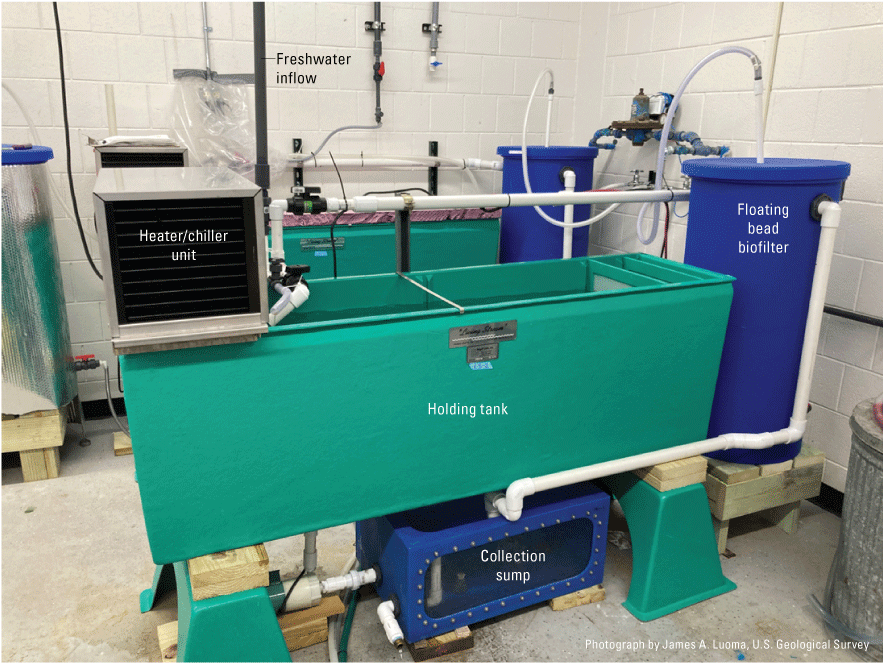
Recirculating system used to maintain Petromyzon marinus consisting of a holding tank, collection sump, floating bead biofilter, heater/chiller unit, and freshwater inflow.
Toxicity Tests
Three independent continuous-flow toxicity tests were completed with each Bayluscide formulation and fish species using the methods described by the American Society for Testing and Materials (ASTM International, 2014) and the “Standard Operating Procedures for Application of Lampricides in the Great Lakes Fishery Commission Integrated Management of Sea Lamprey (Petromyzon marinus) Control Program” (Barber and Van Kempen, 2024). Exposures were 12 hours in duration, and the test animals remained in the test chambers with untreated flow-through well water for an additional 12 hours to assess latent mortality. Tests were completed using continuous-flow diluter systems constructed according to Bills and Johnson (1992; fig. 2). Well water was used in all tests, and untreated water chemistry properties had a mean pH, dissolved oxygen (DO), temperature, alkalinity, and hardness of 7.95 standard units, 9.35 milligrams per liter (mg/L), 13.4 degrees Celsius (°C), 141 mg/L as calcium carbonate calcium carbonate, and 174 mg/L as calcium carbonate, respectively. Each diluter system consisted of nine serially diluted test chambers and an untreated control chamber. The test systems mimicked stream treatments because they steadily increased exposure concentrations over 2–3 hours until they plateaued at peak levels that were then maintained for about 9 hours (fig. 3).
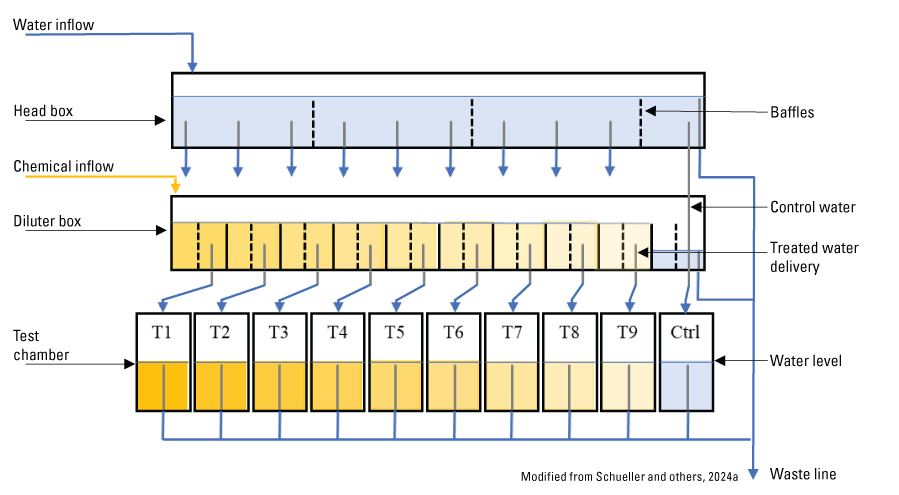
Schematic of the continuous-flow test system used to compare the toxicity of the emulsifiable concentrate and suspension concentrate formulations of 2′,5-dichloro-4′-nitrosalicylanilide ethanolamine salt to Petromyzon marinus (sea lamprey) and representative cold-, cool-, and warm-water nontarget fish (modified from Schueller and others, 2024a).
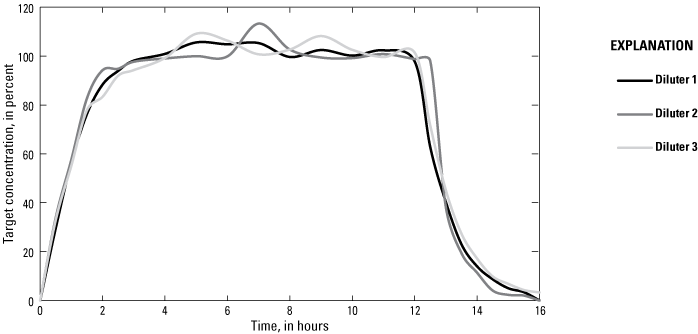
Example concentration profiles from continuous-flow diluter systems used for pesticide formulation comparison exposures (data from the Lepomis macrochirus [bluegill] 20-percent suspension concentration test; data available from Schueller and others [2024b]).
The individual glass test chambers (25 cm wide x 49 cm long x 30.5 cm high) served as the experimental units. Each test chamber contained 10 test animals and 20 L of test water. Test chambers were supplied with a continuous flow of test water at a rate of 500 milliliters per minute, which resulted in about one test chamber volume exchange every 40 minutes. Stock solutions of the Bayluscide test articles were delivered to the diluter mixing boxes using digital peristaltic chemical delivery pumps (Masterflex L/S model 07551–20, Cole-Parmer Instrument Company, Barrington, Ill.). The Bayluscide test articles were mixed and serially diluted with well water flowing from the head box and then delivered to the test chambers (fig. 2). Serial dilutions resulted in each successive Bayluscide concentration being approximately 80 percent of the previous concentration.
Survival Assessments
Survival assessments and removal of dead test animals were completed hourly throughout the exposure period and again 12 hours after test article addition ceased. Mortality was defined as immobility and lack of response to an external stimulus using a blunt probe.
Concentration Verifications
Concentrations of niclosamide in the test chambers were determined from hourly water samples analyzed on an Agilent model 1260 liquid chromatograph system (Agilent Technologies, Inc., Santa Clara, California) equipped with a Kinetex, 2.6 micron, XB–C18, 50 x 2.1-millimeter liquid chromatography column (Phenomenex, Inc., Torrance, Calif.). The injection volume for all samples and standards was 50 microliters. Reference standards and the experimental samples were chromatographed in a 50 °C mobile phase (A=750 milliliter [mL] e-pure water+250 mL mass spectrometry grade methanol+385 milligrams mass spectrometry grade ammonium acetate+3 mL acetic acid; B=1,000 mL methanol+385 milligrams ammonium acetate+3 mL acetic acid) flowing at 1.25 milliliters per minute. Gradient chromatography was applied starting with an A:B ratio of 45:55. The A:B ratio was switched to 30:70 at 0.00 minutes and remained unchanged until 0.50 minute. At 0.50 minutes, a 0.10-minute gradient was applied to reach a final A:B ratio of 45:55 for the duration of the 1.50-minute run. The wavelength of the diode array detector was set at 336.0 nanometers with a reference wavelength of 370.0 nanometers. During the analysis of the experimental test chamber samples, 2 reference standards were injected after every 10 samples, and 5 reference standards were injected after every 30 samples. Calibration curves were created using Agilent ChemStation Software (Agilent Technologies, Inc., Santa Clara, Calif.) and were used to determine sample concentrations.
Water Quality Properties
Water quality properties (temperature, DO, and pH) were measured hourly during the exposure period and at the termination of the post-exposure observation period using a digital thermometer (Thermapen model Mk4, ThermoWorks Company, American Fork, Utah) and a multiparameter water quality meter fitted with an optical DO probe and a digital pH probe (Hach models HQ40d, LDO 10101, and PHC 70501, respectively; Hach Company, Loveland, Colorado). Total water hardness and alkalinity were measured on source water samples collected prior to each exposure and after 6 and 12 hours of exposure according to methods 2340C and 2320B, respectively, as described in Baird and others (2017).
Data Analysis
Data and analysis code for this study are available in Schueller and others (2024b). Water quality, niclosamide concentration, and mortality data were summarized using simple descriptive statistics generated using R and RStudio software (R Core Team, 2021; RStudio Team, 2021). Mean and grand mean water quality values and niclosamide concentrations were derived using data collected from test chambers that contained live test animals at the previous observation time. Data collection ceased from test chambers when there were no surviving test animals between observation times.
The 9-hour peak mean test chamber niclosamide concentrations (the mean concentration observed from hours 3–12 or from hour 3 until cessation of data collection because of complete test animal mortality), and the observed 12-hour post-exposure mortalities in the test chambers were used to generate two-parameter log-logistic dose-response curves for each species and pesticide formulation using the dose-response curve package in R (Ritz and others, 2015). The resulting curves were then used to estimate the concentration of the pesticide lethal to 25, 50, and 99.9 percent of the test organisms (concentration lethal to 25 percent of test animals [LC25], concentration lethal to 50 percent of test animals [LC50], and concentration lethal to 99.9 percent of test animals [LC99.9], respectively). Differences among LC values in each species were determined by comparing the 95-percent confidence intervals. Significance was declared when separation of confidence intervals was observed.
Results
Test animal were of the same origin and their sizes were similar between formulations (table 1). Water quality properties were also similar among tests and remained well within suitable parameters (ASTM International, 2014). Mean DO ranged from 9.1 to 9.5 mg/L with corresponding oxygen saturations greater than 85-percent, mean pH values ranged from 7.93 to 8.09, and mean water temperatures ranged from 12.4 to 14.0 °C (table 2).
Table 1.
Mean size of Petromyzon marinus (sea lamprey), Oncorhynchus mykiss (rainbow trout), Lepomis macrochirus (bluegill), and Perca flavescens (yellow perch) test animals used in continuous-flow toxicity tests by pesticide formulation test group.[Standard deviation values are in parentheses]
Table 2.
Mean water chemistry properties measured during continuous-flow toxicity tests by test animal and pesticide formulation test group for Petromyzon marinus (sea lamprey), Oncorhynchus mykiss (rainbow trout), Lepomis macrochirus (bluegill), and Perca flavescens (yellow perch).[Standard deviation values are in parentheses. mg/L, milligram per liter;°C, degrees Celsius; CaCO3, calcium carbonate]
In all test replicates, control survival was 100 percent, at least one test chamber had partial mortality, and at least one chamber had complete mortality. Two-parameter log-logistic dose-response curves for species and formulation (fig. 4) were used to estimate the LC25, LC50, and LC99.9 for each species (fig. 5). No differences between formulations were detected in the sea lamprey LC values or the LC99.9 values of the same nontarget species. Although differences exist among the LC25 and LC50 values for nontarget species, the differences were minimal and the suspension concentrate formulation was less toxic to nontarget species.
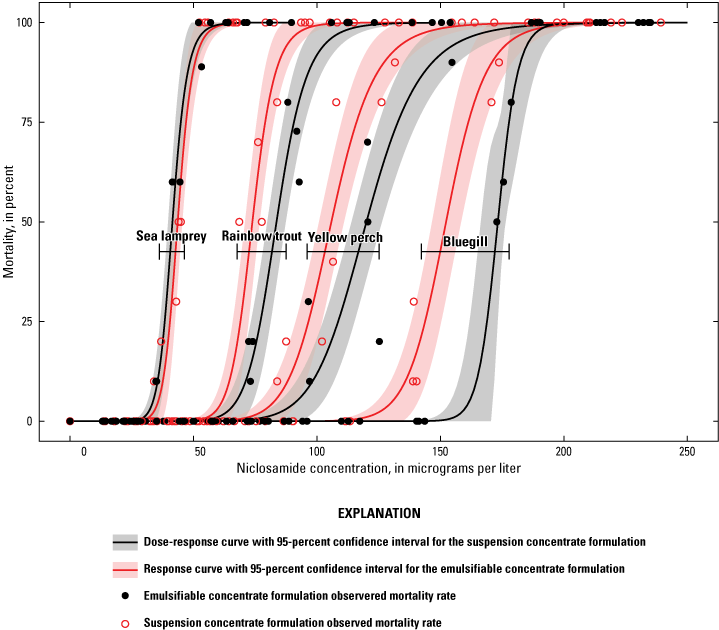
Dose-response curves with 95-percent confidence intervals for Petromyzon marinus (sea lamprey), Oncorhynchus mykiss (rainbow trout), Perca flavescens (yellow perch), and Lepomis macrochirus (bluegill) exposed to the emulsifiable concentrate or the suspension concentrate formulation for 12 hours in a continuous-flow diluter system.
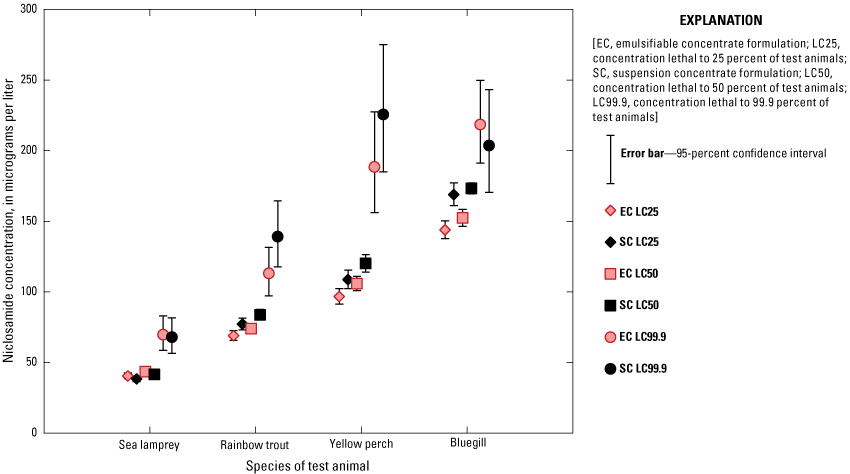
Estimated concentrations and 95-percent confidence intervals lethal to 25, 50, and 99.9 percent (LC25, LC50, and LC99.9) of the Petromyzon marinus (sea lamprey), Oncorhynchus mykiss (rainbow trout), Perca flavescens (yellow perch), and Lepomis macrochirus (bluegill) when exposed to the emulsifiable concentrate or the suspension concentrate formulation for 12 hours in a continuous-flow diluter.
Discussion
The presence of a small quantity of an antimicrobial in the Bayluscide SC formulation warranted a comparative toxicity evaluation against the currently registered Bayluscide EC formulation to provide evidence that could be used to determine the suitability of the Bayluscide SC formulation for inclusion in the GLFC binational sea lamprey control program.
There were nonsignificant differences in the toxicity between the formulations in the target species, sea lamprey. Differences in the LC25 and LC50 values of the pesticide formulations within nontarget species were minimal and no differences were detected in the LC99.9 values of the same species (fig. 5). In contrast to sea lamprey, the SC formulation was less toxic to nontarget species than the EC formulation in all but one case (bluegill LC99.9; fig. 5). The toxicity of both formulations is comparable to the toxicity of niclosamide reported by Marking and Hogan (1967) and Dawson and others (1977).
Although only speculative, the observed differences in Bayluscide formulation toxicity could be related to inert ingredients. The EC formulation contains a surfactant and an organic solvent, which may increase niclosamide solubility and uptake, resulting in higher toxicity. Although minimal, the differences in formulation toxicity may provide increased protection of nontarget species (figs. 4 and 5). Additional investigation may determine if the coapplication of SC formulation with TFM will increase protection to nontarget species. Lake sturgeon (Acipenser fulvescens) is a culturally important species and they are also known to be sensitive to lampricides (Boogaard and others, 2003). Determining if the coapplication of the SC formulation with TFM would increase protection to lake sturgeon could benefit the GLFC binational sea lamprey control program by reducing treatment-related effects to this important species.
The coapplication of Bayluscide with TFM during larval sea lamprey stream treatments can reduce the amount of TFM required by as much as 50 percent while maintaining a selective toxicity profile (Associate Committee on Scientific Criteria for Environmental Quality, 1985; Dawson, 2003). The reduced amount of TFM required for an effective treatment because of the addition of Bayluscide can result in substantial savings. Our tests demonstrate the SC formulation has a similar toxicity profile to the EC formulation. The similar toxicity profile, water soluble characteristics, and more environmentally friendly inert ingredients indicate the SC formulation could be a suitable pesticide for incorporation into the GLFC binational sea lamprey control program. The SC formulation has potential to improve worker safety and reduce application problems and expenses associated with equipment deterioration and cleanup.
Conclusion
This report describes the results of comparative toxicity tests of Bayluscide formulations to inform regulatory decisions for a new Bayluscide 20-percent suspension concentrate (SC) formulation. Continuous-flow and stream treatment mimicking laboratory exposures were completed. Then, comparisons were made between the resulting concentrations lethal to 25, 50 and 99.9 percent of the test animals calculated for each formulation and species. The results demonstrate that the toxicity of the new Bayluscide 20-percent SC formulation does not differ from the toxicity of the Bayluscide 20-percent emulsifiable concentrate formulation to larval sea lamprey and it is slightly less toxic to nontarget species. The results support the continued evaluation and potential registration of the new Bayluscide 20-percent SC formulation for use in the binational sea lamprey control program.
References Cited
Applegate, V.C., Howell, J.H., and Smith, M.A., 1958, Use of mononitrophenols containing halogens as selective sea lamprey larvicides: Science, v. 127, no. 3294, p. 336–338, accessed Feb. 5, 2014, at https://doi.org/10.1126/science.127.3294.336.
Barber, J.M., and Van Kempen, T., 2024, Standard operating procedures for application of lampricides in the Great Lakes Fishery Commission integrated management of sea lamprey (Petromyzon marinus) control program: U.S. Fish and Wildlife Service and Fisheries and Oceans Canada, variously paged, accessed May 14, 2024, at https://www.glfc.org/sop.php.
Bills, T.D., and Johnson, D.A., 1992, Effect of pH on the toxicity of TFM to sea lamprey larvae and nontarget species during a stream treatment: Great Lakes Fishery Commission, U.S. Fish and Wildlife Service Technical Report 57, p. 7–19, also available at https://pubs.usgs.gov/publication/2002436.
Boogaard, M.A., Bills, T.D., and Johnson, D.A., 2003, Acute toxicity of TFM and a TFM/niclosamide mixture to selected species of fish, including lake sturgeon (Acipenser fulvescens) and mudpuppies (Necturus maculosus), in laboratory and field exposures: Journal of Great Lakes Research, v. 29, p. 529–541, also available at https://doi.org/10.1016/S0380-1330(03)70514-0.
Dawson, V.K., 2003, Environmental fate and effects of the lampricide Bayluscide—A review: Journal of Great Lakes Research, v. 29, p. 475–492, also available at https://doi.org/10.1016/S0380-1330(03)70509-7.
Dawson, V.K., Cumming, K.B., and Gilderhus, P.A., 1977, Efficacy of 3-trifluoromethyl-4-nitrophenol (TFM), 2′,5-dichloro-4′-nitrosalicylanilide (Bayer 73), and a 98:2 mixture of lampricides in laboratory studies in Investigations in fish control, report no. 77: Washington, D.C., U.S. Department of the Interior, Fish and Wildlife Service, p. 1–11, also available at https://pubs.usgs.gov/ifc/077/report.pdf.
Howell, J.H., King, E.L., Smith, A.J., and Hanson, L.H., 1964, Synergism of 5,2′-dichloro-4′-nitro-salicylanilide and 3-trifluormethyl-4-nitrophenol in a selective lamprey larvicide: Great Lakes Fishery Commission Technical Report no. 8., 21 p., also available at https://www.glfc.org/pubs/TechReports/Tr08.pdf.
Larval Assessment Task Force, 2019, Larval assessment sampling protocol using the AbP-2 backpack electrofisher in Great Lakes streams: Great Lakes Fishery Commission, 36 p., accessed February 24, 2023, at http://www.glfc.org/sop2018/app/app%20s%20Larval%20Assessment%20Sampling%20Protocol.pdf.
R Core Team, 2021, R—A language and environment for statistical computing, version 4.1.1: R Foundation for Statistical Computing, Vienna, Austria, accessed August 10, 2021, at https://www.R-project.org/.
Ritz, C., Baty, F., Streibig, J.C., and Gerhard, D., 2015, Dose-response analysis using R: PLoS One, v. 10, no. 12, 13 p., accessed December 30, 2015, at https://doi.org/10.1371/journal.pone.0146021.
RStudio Team, 2021, RStudio—Integrated development for R: RStudio, Version 2021.09.0, accessed May 14, 2024 at https://www.rstudio.com/.
Schueller, J.R., Boogaard, M.A., Kirkeeng, C.A., Schloesser, N.A., Wolfe, S.A., Lettenberger, A.J., King-Heiden, T.C., and Luoma, J.A., 2024a, Seasonal differences in larval sea lamprey (Petromyzon marinus) sensitivity to the pesticide TFM: Journal of Great Lakes Research, v. 50, no. 1, also available at https://doi.org/10.1016/j.jglr.2023.102248.
Schueller, J.R., Luoma, J.A., Schloesser, N.A., Kirkeeng, C.A., Wolfe, S.L., and Barbour, M.T., 2024b, Data and code release—Comparative toxicity of emulsifiable concentrate and suspension concentrate formulations of 2′,5-dichloro-4′-nitrosalicylanilide ethanolamine salt: U.S. Geological Survey data release, https://doi.org/10.5066/P1473X4B.
Siefkes, M.J., 2017, Use of physiological knowledge to control the invasive sea lamprey (Petromyzon marinus) in the Laurentian Great Lakes: Conservation Physiology, v. 5, no. 1, accessed July 6, 2018, at https://doi.org/10.1093/conphys/cox031.
Smith, B.R., and Tibbles, J.J., 1980, Sea lamprey (Petromyzon marinus) in Lakes Huron, Michigan, and Superior—History of invasion and control, 1936–78: Canadian Journal of Fisheries and Aquatic Sciences, v. 37, no. 11, p. 1780–1801, accessed May 7, 2019, at https://doi.org/10.1139/f80-222.
Sullivan, W.P., Burkett, D.P., Boogaard, M.A., Criger, L.A., Freiburger, C.E., Hubert, T.D., Leistner, K.G., Morrison, B.J., Nowicki, S.M., Robertson, S.N.P., Rowlinson, A.K., Scotland, B.J., and Sullivan, T.B., 2021, Advances in the use of lampricides to control sea lampreys in the Laurentian Great Lakes, 2000–2019: Journal of Great Lakes Research, v. 47, p. S216–S237, accessed May 14, 2024, at https://doi.org/10.1016/j.jglr.2021.08.009.
Wilkie, M.P., Hubert, T.D., Boogaard, M.A., and Birceanu, O., 2019, Control of invasive sea lampreys using the piscicides TFM and niclosamide—Toxicology, successes & future prospects: Aquatic Toxicology (Amsterdam, Netherlands), v. 211, p. 235–252, accessed May 14, 2024, at https://doi.org/10.1016/j.aquatox.2018.12.012.
Conversion Factors
International System of Units to U.S. customary units
Temperature in degrees Celsius (°C) may be converted to degrees Fahrenheit (°F) as follows:
°F = (1.8 × °C)+ 32.
Supplemental Information
Concentrations of chemical constituents in water are given in milligrams per liter (mg/L).
Continuous flow is given in milliliters per minute (mL/min).
Abbreviations
Bayluscide
2′,5-dichloro-4′-nitrosalicylanilide ethanolamine salt
DO
dissolved oxygen
EC
emulsifiable concentrate
GLFC
Great Lakes Fishery Commission
LC
lethal concentration
LC25
concentration lethal to 25 percent of test animals
LC50
concentration lethal to 50 percent of test animals
LC99.9
concentration lethal to 99.9 percent of test animals
niclosamide
2′,5-dichloro-4′-nitrosalicylanilide
SC
suspension concentrate
TFM
4-nitro-3-(trifluoromethyl)phenol
UMESC
Upper Midwest Environmental Sciences Center
For more information about this publication, contact:
Director, USGS Upper Midwest Environmental Sciences Center
2630 Fanta Reed Rd.
La Crosse, WI 54603
608–783–6451
For additional information, visit: https://www.usgs.gov/centers/upper-midwest-environmental-sciences-center
Publishing support provided by the
Rolla Publishing Service Center
Disclaimers
Any use of trade, firm, or product names is for descriptive purposes only and does not imply endorsement by the U.S. Government.
Although this information product, for the most part, is in the public domain, it also may contain copyrighted materials as noted in the text. Permission to reproduce copyrighted items must be secured from the copyright owner.
Suggested Citation
Luoma, J.A., Schueller, J.R., Schloesser, N.A., Kirkeeng, C.A., and Wolfe, S.L., 2024, Comparative toxicity of emulsifiable concentrate and suspension concentrate formulations of 2′,5-dichloro-4′-nitrosalicylanilide ethanolamine salt: U.S. Geological Survey Open-File Report 2024–1037, 10 p., https://doi.org/10.3133/ofr20241037.
ISSN: 2331-1258 (online)
| Publication type | Report |
|---|---|
| Publication Subtype | USGS Numbered Series |
| Title | Comparative toxicity of emulsifiable concentrate and suspension concentrate formulations of 2′,5-dichloro-4′-nitrosalicylanilide ethanolamine salt |
| Series title | Open-File Report |
| Series number | 2024-1037 |
| DOI | 10.3133/ofr20241037 |
| Publication Date | July 11, 2024 |
| Year Published | 2024 |
| Language | English |
| Publisher | U.S. Geological Survey |
| Publisher location | Reston, VA |
| Contributing office(s) | Upper Midwest Environmental Sciences Center |
| Description | Report: vii, 10 p.; Data Release |
| Online Only (Y/N) | Y |
| Additional Online Files (Y/N) | N |


